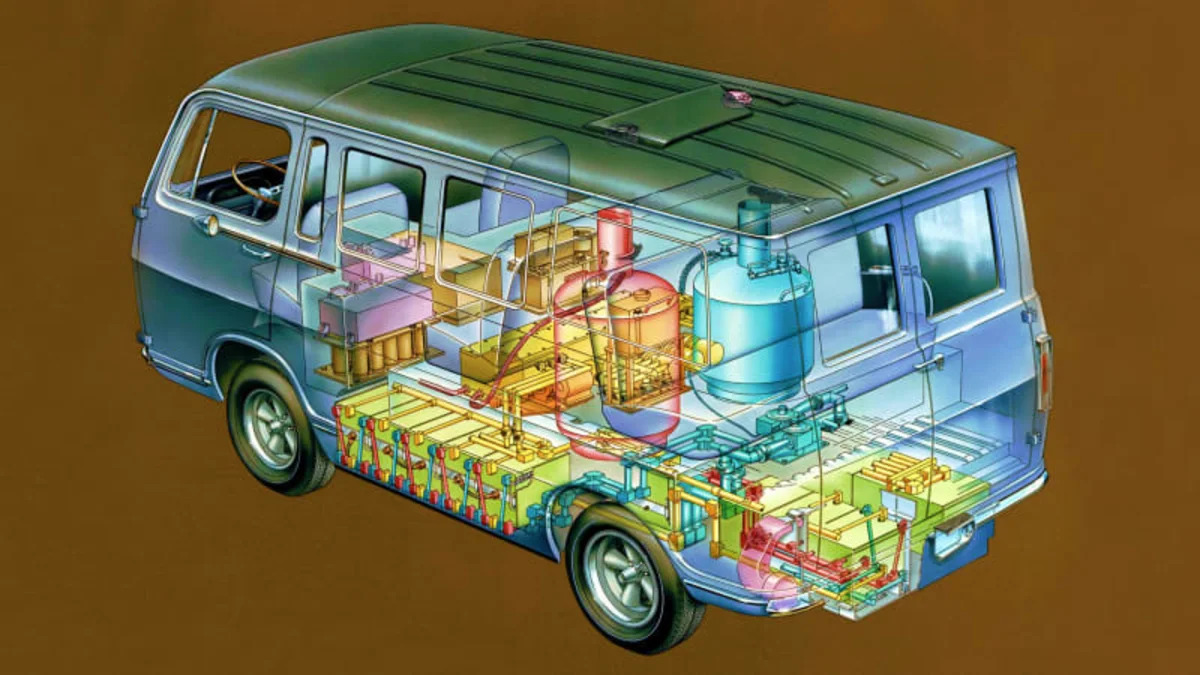Update: A previous of version of this story incorrectly stated the Electrovan used lead-acid batteries. It actually used silver-zinc batteries. The text has been changed to reflect this.
General Motors understandably made a big deal about the Chevy Camaro turning 50 this year. But the company has another important vehicle celebrating its 50th, one that introduced technologies that have only hit the streets in this millennium. That vehicle is the Electrovan, and it was the world's first hydrogen fuel-cell vehicle.
The Electrovan was based on a common G-series van, since all the fuel-cell components had to go somewhere, and they weren't small. There was only space for two occupants and the rear of the van was filled with sliver-zinc batteries and large storage tanks for liquid oxygen and hydrogen. On the outside, it looked quite ordinary, except for the sweet set of mag wheels and white-line tires. Impressively, the van could travel between 100 and 150 miles between fill-ups.
The project also came together quickly. Two hundred people worked three shifts to finish the project, which took only 10 months from January to October 1966. Of course as we all know, it took much longer for the technology to reach the hands of consumers, and still only one car is available for people to outright purchase.
The future is also a bit cloudy for hydrogen fuel cells, as electric vehicles have developed quickly and taken significant market share. However, Honda still intends to offer the new Clarity by the end of the year, Toyota is currently selling the Mirai, and Chevy introduced a new hydrogen truck intended for military use. The latter will undergo testing shortly. So there could still be a future for hydrogen cars, and they owe a lot to GM's Electrovan.
Related Video:
General Motors understandably made a big deal about the Chevy Camaro turning 50 this year. But the company has another important vehicle celebrating its 50th, one that introduced technologies that have only hit the streets in this millennium. That vehicle is the Electrovan, and it was the world's first hydrogen fuel-cell vehicle.
The Electrovan was based on a common G-series van, since all the fuel-cell components had to go somewhere, and they weren't small. There was only space for two occupants and the rear of the van was filled with sliver-zinc batteries and large storage tanks for liquid oxygen and hydrogen. On the outside, it looked quite ordinary, except for the sweet set of mag wheels and white-line tires. Impressively, the van could travel between 100 and 150 miles between fill-ups.
The project also came together quickly. Two hundred people worked three shifts to finish the project, which took only 10 months from January to October 1966. Of course as we all know, it took much longer for the technology to reach the hands of consumers, and still only one car is available for people to outright purchase.
The future is also a bit cloudy for hydrogen fuel cells, as electric vehicles have developed quickly and taken significant market share. However, Honda still intends to offer the new Clarity by the end of the year, Toyota is currently selling the Mirai, and Chevy introduced a new hydrogen truck intended for military use. The latter will undergo testing shortly. So there could still be a future for hydrogen cars, and they owe a lot to GM's Electrovan.
Related Video:


Sign in to post
Please sign in to leave a comment.
Continue